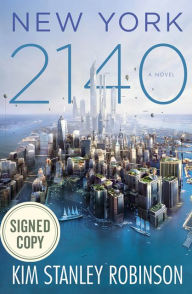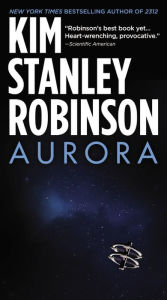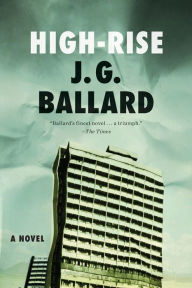New York 2140 Offers a Fascinating Tour of a Drowned Manhattan
 In his 2015 novel Aurora, Kim Stanley Robinson brackets events taking place largely on a generation ship with two long sequences on or in the water: a father takes his daughter for an afternoon of leisurely sailing (an event that causes vertigo when you discover the pond is governed by the strange gravity of the generation ship itself); and a woman who was raised largely in space goes tumbling and swimming in the ocean surf, acquainting herself with the planet of origin.
In his 2015 novel Aurora, Kim Stanley Robinson brackets events taking place largely on a generation ship with two long sequences on or in the water: a father takes his daughter for an afternoon of leisurely sailing (an event that causes vertigo when you discover the pond is governed by the strange gravity of the generation ship itself); and a woman who was raised largely in space goes tumbling and swimming in the ocean surf, acquainting herself with the planet of origin.
New York 2140 (Signed Book)
New York 2140 (Signed Book)
Hardcover
$19.73
$28.00
So too begins an early chapter of New York 2140: in a future that no longer has the luxury of debating about the reality of climate change, hedge fund manager Franklin, who works in the Intertidal Property Pricing Index, which allows investors to place bets on when and where the sea levels will surge again, hops into his zoomer and sails through the drowned streets of New York City to his office in the financial district. It is a century and more into the future, and sea levels are 50 feet higher than they are today. New York is the Venice of America.
Like Robinson’s other future histories (2312, the Mars trilogy), this is somewhat meandering novel, ebbing and flowing in the New York City environs. It follows a handful of protagonists on their disparate adventures, with through-lines that intersect in the Met Life Tower in some way: several are residents of the office building-turned-residential cooperative, either full or part time; some are squatters; a few are water rats lashed against the building for the night. Several floors of the tower are underwater, like most of the city below 34th St.; several more were broken out to serve as boathouse (if the city has endured, so too have the jokes about the difficulty of finding a good parking spot). The spired roof houses gardens that produce food for the building’s denizens. As the residents crisscross the city on their various intertwining trajectories, Robinson gives us a water-level view.
So too begins an early chapter of New York 2140: in a future that no longer has the luxury of debating about the reality of climate change, hedge fund manager Franklin, who works in the Intertidal Property Pricing Index, which allows investors to place bets on when and where the sea levels will surge again, hops into his zoomer and sails through the drowned streets of New York City to his office in the financial district. It is a century and more into the future, and sea levels are 50 feet higher than they are today. New York is the Venice of America.
Like Robinson’s other future histories (2312, the Mars trilogy), this is somewhat meandering novel, ebbing and flowing in the New York City environs. It follows a handful of protagonists on their disparate adventures, with through-lines that intersect in the Met Life Tower in some way: several are residents of the office building-turned-residential cooperative, either full or part time; some are squatters; a few are water rats lashed against the building for the night. Several floors of the tower are underwater, like most of the city below 34th St.; several more were broken out to serve as boathouse (if the city has endured, so too have the jokes about the difficulty of finding a good parking spot). The spired roof houses gardens that produce food for the building’s denizens. As the residents crisscross the city on their various intertwining trajectories, Robinson gives us a water-level view.
Aurora
Aurora
Paperback $9.99
It would be easy to mistake this novel as a grim exercise in prognosticating future calamity: Look at how horrific everything will be once the waters inevitably rise! Certainly, there’s a lot wrong with the world in 2140, both in New York and beyond. One of the part-time residents of Met Life is the principal of a reality show wherein she works to preserve extremely threatened animal populations using a nifty airship called Assisted Migration. Her mission at the start of the novel is to ferry some dozen polar bears from the Arctic to the Antarctic. (Whatever Coke commercials might have told you, penguins and polar bears have never coexisted, but they might have to in 2140.) As there is no land in the Arctic, and precious little ice, moving some of the 200 odd polar bears left in the world to the Antarctic, where there still is land, and ice, and seals to eat, seems like the most practical bid to save the species. Things don’t go precisely as planned, but it makes for good television.
The sequence with the polar bears is both hopeful and resigned. It feels precisely like watching an individual, or a small group of citizens, working doggedly against global forces to the betterment of said globe, and having that work out like it inevitably does. Which is to say, with real sacrifices, and gains that can barely be measured in inches on the Intertidal Property Pricing Index. Though New York 2140 is set in our near future, it supplies pointed commentary more about today than any inevitable (or avoidable) future. One plot line follows the building manager as she and the board deal with an offer to buy the building, and by extension, the cooperative; gentrification continues to be a problem in our drowned future. A New Amsterdam flotilla disgorges refugees from Kingston, Jamaica, and a civil servant works doggedly to process them, with all of the positive and negative connotations of the verb “to process.” Two young children, homeless but not hopeless, try for buried treasure in a diving bell they built themselves, a dream of gold in the continent that has always both supported and punished such optimism.
It would be easy to mistake this novel as a grim exercise in prognosticating future calamity: Look at how horrific everything will be once the waters inevitably rise! Certainly, there’s a lot wrong with the world in 2140, both in New York and beyond. One of the part-time residents of Met Life is the principal of a reality show wherein she works to preserve extremely threatened animal populations using a nifty airship called Assisted Migration. Her mission at the start of the novel is to ferry some dozen polar bears from the Arctic to the Antarctic. (Whatever Coke commercials might have told you, penguins and polar bears have never coexisted, but they might have to in 2140.) As there is no land in the Arctic, and precious little ice, moving some of the 200 odd polar bears left in the world to the Antarctic, where there still is land, and ice, and seals to eat, seems like the most practical bid to save the species. Things don’t go precisely as planned, but it makes for good television.
The sequence with the polar bears is both hopeful and resigned. It feels precisely like watching an individual, or a small group of citizens, working doggedly against global forces to the betterment of said globe, and having that work out like it inevitably does. Which is to say, with real sacrifices, and gains that can barely be measured in inches on the Intertidal Property Pricing Index. Though New York 2140 is set in our near future, it supplies pointed commentary more about today than any inevitable (or avoidable) future. One plot line follows the building manager as she and the board deal with an offer to buy the building, and by extension, the cooperative; gentrification continues to be a problem in our drowned future. A New Amsterdam flotilla disgorges refugees from Kingston, Jamaica, and a civil servant works doggedly to process them, with all of the positive and negative connotations of the verb “to process.” Two young children, homeless but not hopeless, try for buried treasure in a diving bell they built themselves, a dream of gold in the continent that has always both supported and punished such optimism.
High-Rise
High-Rise
Paperback $14.95
The future Robinson imagines is neither dystopia nor utopia, but an odd mix of both. Unlike The Drowned World by J.G. Ballard, which also envisions a future earth swamped by rising sea levels, New York 2140 doesn’t sink into the depths of metaphor and the psychological. Not overtly, anyway; the landscapes and people bend to meet Ballard’s (snarling, prescient) metaphor, but Robinson is both more sensible and more plausible, grounded in the earth now found 50 feet below sea level. (Ballard’s High-Rise would also make a good counterpoint to New York 2140: compare/contrast the people of Met Life with the citizens of Ballard’s unnamed brutalist high-rise.) Both authors create characters who are recognizably people, with their wants and needs legible and recognizable (if occasionally outsized), but Robinson’s New York comes to life with the tang of hard science and the hard-knuckled history of place (intermittent chapters from the point-of-view of “a citizen” offer wide-ranging history and commentary on the peculiarities of the Big Apple). While I’m setting these two writers up as a dialectic, I want to make clear I find their differences energizing, these profoundly different ways of envisioning the near future (or, let’s not be coy, different ways of envisioning the present.)
Robinson has always been an omnivorous hard science writer, as willing to throw himself into the complexities of high finance as the minutia of tidal forces in the East River. This is going to be a long-winded analogy, but hear me out: I very much enjoyed the nerdy science experiments of Andy Weir’s The Martian, which follows the travails of an astronaut accidentally abandoned on Mars to fend for himself. It is less a novel of characters than an enjoyable set of thought experiments delivered in a voice charming enough to humanize the science. (That opening line is Top 5 for me.)
The film adaptation, directed by the inimitable Ridley Scott, ends up being a landscape picture. He replicates a few of Weir’s science asides, but as the narrative progresses, the astronaut grows more and more silent, the camera tracking the harsh Martian landscape in stunning, visceral vistas. I sat in the dark theater, completely pinioned by the stark beauty of an alien world. That slow tracking shot is the boiling blood of science fiction, the what if that sets us down on other worlds. Robinson’s New York 2140 blends both of these things, and more—the wondrous vision, the fascinating science, and the history that underpins everything we do. It isn’t the best of both worlds; it’s the best of this one, spun forward into a future as hopeful and hopeless as today.
New York 2140 is available March 14 in a signed edition from Barnes & Noble.
The future Robinson imagines is neither dystopia nor utopia, but an odd mix of both. Unlike The Drowned World by J.G. Ballard, which also envisions a future earth swamped by rising sea levels, New York 2140 doesn’t sink into the depths of metaphor and the psychological. Not overtly, anyway; the landscapes and people bend to meet Ballard’s (snarling, prescient) metaphor, but Robinson is both more sensible and more plausible, grounded in the earth now found 50 feet below sea level. (Ballard’s High-Rise would also make a good counterpoint to New York 2140: compare/contrast the people of Met Life with the citizens of Ballard’s unnamed brutalist high-rise.) Both authors create characters who are recognizably people, with their wants and needs legible and recognizable (if occasionally outsized), but Robinson’s New York comes to life with the tang of hard science and the hard-knuckled history of place (intermittent chapters from the point-of-view of “a citizen” offer wide-ranging history and commentary on the peculiarities of the Big Apple). While I’m setting these two writers up as a dialectic, I want to make clear I find their differences energizing, these profoundly different ways of envisioning the near future (or, let’s not be coy, different ways of envisioning the present.)
Robinson has always been an omnivorous hard science writer, as willing to throw himself into the complexities of high finance as the minutia of tidal forces in the East River. This is going to be a long-winded analogy, but hear me out: I very much enjoyed the nerdy science experiments of Andy Weir’s The Martian, which follows the travails of an astronaut accidentally abandoned on Mars to fend for himself. It is less a novel of characters than an enjoyable set of thought experiments delivered in a voice charming enough to humanize the science. (That opening line is Top 5 for me.)
The film adaptation, directed by the inimitable Ridley Scott, ends up being a landscape picture. He replicates a few of Weir’s science asides, but as the narrative progresses, the astronaut grows more and more silent, the camera tracking the harsh Martian landscape in stunning, visceral vistas. I sat in the dark theater, completely pinioned by the stark beauty of an alien world. That slow tracking shot is the boiling blood of science fiction, the what if that sets us down on other worlds. Robinson’s New York 2140 blends both of these things, and more—the wondrous vision, the fascinating science, and the history that underpins everything we do. It isn’t the best of both worlds; it’s the best of this one, spun forward into a future as hopeful and hopeless as today.
New York 2140 is available March 14 in a signed edition from Barnes & Noble.


